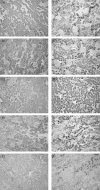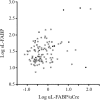Renal expression and urinary excretion of liver-type fatty acid-binding protein in cats with renal disease
- PMID: 32087614
- PMCID: PMC7096645
- DOI: 10.1111/jvim.15721
Renal expression and urinary excretion of liver-type fatty acid-binding protein in cats with renal disease
Abstract
Background: Liver-type fatty acid-binding protein (L-FABP) is a biomarker for early detection of renal disease in humans. Liver-type fatty acid-binding protein is cytotoxic oxidation products secreted from proximal tubules under ischemia and oxidative stress.
Objective: To examine renal expression and quantify urinary excretion of L-FABP in catswith renal disease.
Animals: One hundred and thirty-four client-owned cats including 34 cats with serum creatinine (sCre) values >1.6 mg/dL and 10 other cats that died in clinics.
Methods: Tissue expressions of L-FABP were examined by reverse transcription polymerase chain reaction and Western blotting. Urinary L-FABP (uL-FABP) and serum L-FABP (sL-FABP) levels were determined by enzyme-linked immunosorbent assay. Anti-liver-type fatty acid-binding protein antibody immunostained renal sections.
Results: Feline kidneys express L-FABP. Strong L-FABP signals were observed in the lumens of proximal tubular cells in 5 cats with high uL-FABP excretion, but not in 5 cats with low uL-FABP excretion. In 9 normal cats, uL-FABP index was <1.2 μg/g urinary creatinine (uCre). High uL-FABP indexes (>10.0 μg/g uCre) were detected in 7 of 100 cats with low sCre (<1.6 mg/dL) and 18 of 44 cats with high sCre (>1.6 mg/dL). There was a weak correlation between L-FABP index and sCre, serum symmetric dimethylarginine (SDMA), or blood urea nitrogen (BUN), and these correlation coefficients were increased by analyzing only data of cats with sCre >1.6 mg/dL. There was a weak correlation between u L-FABP index and sL-FABP in all tested cats, but not in cats with high sCre.
Conclusions and clinical importance: This study demonstrates correlations between L-FABP and current renal biomarkers for chronic kidney disease in cats, such as sCre and SDMA. Liver-type fatty acid-binding protein may be a potential biomarker to predict early pathophysiological events in feline kidneys.
Keywords: acute kidney injury; biomarker; chronic kidney disease; kidney.
© 2020 The Authors. Journal of Veterinary Internal Medicine published by Wiley Periodicals, Inc. on behalf of the American College of Veterinary Internal Medicine.
Conflict of interest statement
Tsuyoshi Oikawa, Keiichi Ohata, and Takeshi Sugaya are senior scientists of CMIC Holdings Co. Ltd (Tokyo, Japan), a company that produced the high sensitivity L‐FABP ELISA kits for L‐FABP analysis. No other potential conflicts of interest relevant to this article are reported.
Figures






Similar articles
-
Preliminary study of urinary excretion of liver-type fatty acid-binding protein in a cat model of chronic kidney disease.Can J Vet Res. 2021 Apr;85(2):156-160. Can J Vet Res. 2021. PMID: 33883825 Free PMC article.
-
Urinary liver-type fatty acid-binding protein in clinically healthy elderly cats: Evaluation of its potential to detect IRIS stage 1 chronic kidney disease and borderline proteinuria.Vet Med Sci. 2023 Jan;9(1):3-12. doi: 10.1002/vms3.1003. Epub 2022 Nov 23. Vet Med Sci. 2023. PMID: 36418182 Free PMC article.
-
Temporal changes in urinary excretion of liver-type fatty acid binding protein (L-FABP) in acute kidney injury model of domestic cats: a preliminary study.J Vet Med Sci. 2019 Dec 26;81(12):1868-1872. doi: 10.1292/jvms.19-0325. Epub 2019 Oct 22. J Vet Med Sci. 2019. PMID: 31645505 Free PMC article.
-
[L-type fatty acid binding protein (L-FABP) and kidney disease].Rinsho Byori. 2014 Feb;62(2):163-70. Rinsho Byori. 2014. PMID: 24800492 Review. Japanese.
-
[Urinary L-type fatty acid binding protein (L-FABP) as a new urinary biomarker promulgated by the Ministry of Health, Labour and Welfare in Japan].Rinsho Byori. 2013 Jul;61(7):635-40. Rinsho Byori. 2013. PMID: 24205707 Review. Japanese.
Cited by
-
Renal biomarkers in cats: A review of the current status in chronic kidney disease.J Vet Intern Med. 2022 Mar;36(2):379-396. doi: 10.1111/jvim.16377. Epub 2022 Feb 26. J Vet Intern Med. 2022. PMID: 35218249 Free PMC article. Review.
-
Reduction of urinary felinine in domestic cats with renal diseases leads to decreased catty odor.J Vet Med Sci. 2025 Jan 10;87(1):61-67. doi: 10.1292/jvms.24-0370. Epub 2024 Dec 3. J Vet Med Sci. 2025. PMID: 39631957 Free PMC article.
-
Preliminary study of urinary excretion of liver-type fatty acid-binding protein in a cat model of chronic kidney disease.Can J Vet Res. 2021 Apr;85(2):156-160. Can J Vet Res. 2021. PMID: 33883825 Free PMC article.
-
Urinary D-amino acid profiles in cats with chronic kidney disease.J Vet Med Sci. 2024 Aug 2;86(8):855-859. doi: 10.1292/jvms.24-0023. Epub 2024 Jun 7. J Vet Med Sci. 2024. PMID: 38853004 Free PMC article.
-
Urinary liver-type fatty acid-binding protein in clinically healthy elderly cats: Evaluation of its potential to detect IRIS stage 1 chronic kidney disease and borderline proteinuria.Vet Med Sci. 2023 Jan;9(1):3-12. doi: 10.1002/vms3.1003. Epub 2022 Nov 23. Vet Med Sci. 2023. PMID: 36418182 Free PMC article.
References
-
- Elliott J, Barber PJ. Feline chronic renal failure: clinical findings in 80 cases diagnosed between 1992 and 1995. J Small Anim Pract. 1998;39:78‐85. - PubMed
-
- Lulich JP, O'Brien TD, Osborne CA, et al. Feline renal failure: questions, answers, questionscompendium on continuing education for the practicing veterinarian. 1992;14:127‐152.
-
- White JD, Malik R, Norris JM. Feline chronic kidney disease: can we move from treatment to prevention? Vet J. 2011;190:317‐322. - PubMed
-
- Jepson RE, Brodbelt D, Vallance C, Syme HM, Elliott J. Evaluation of predictors of the development of azotemia in cats. J Vet Intern Med. 2009;23:806‐813. - PubMed
-
- Chakrabarti S, Syme HM, Elliott J. Clinicopathological variables predicting progression of azotemia in cats with chronic kidney disease. J Vet Intern Med. 2012;26:275‐281. - PubMed
MeSH terms
Substances
Grants and funding
LinkOut - more resources
Full Text Sources
Medical
Miscellaneous

